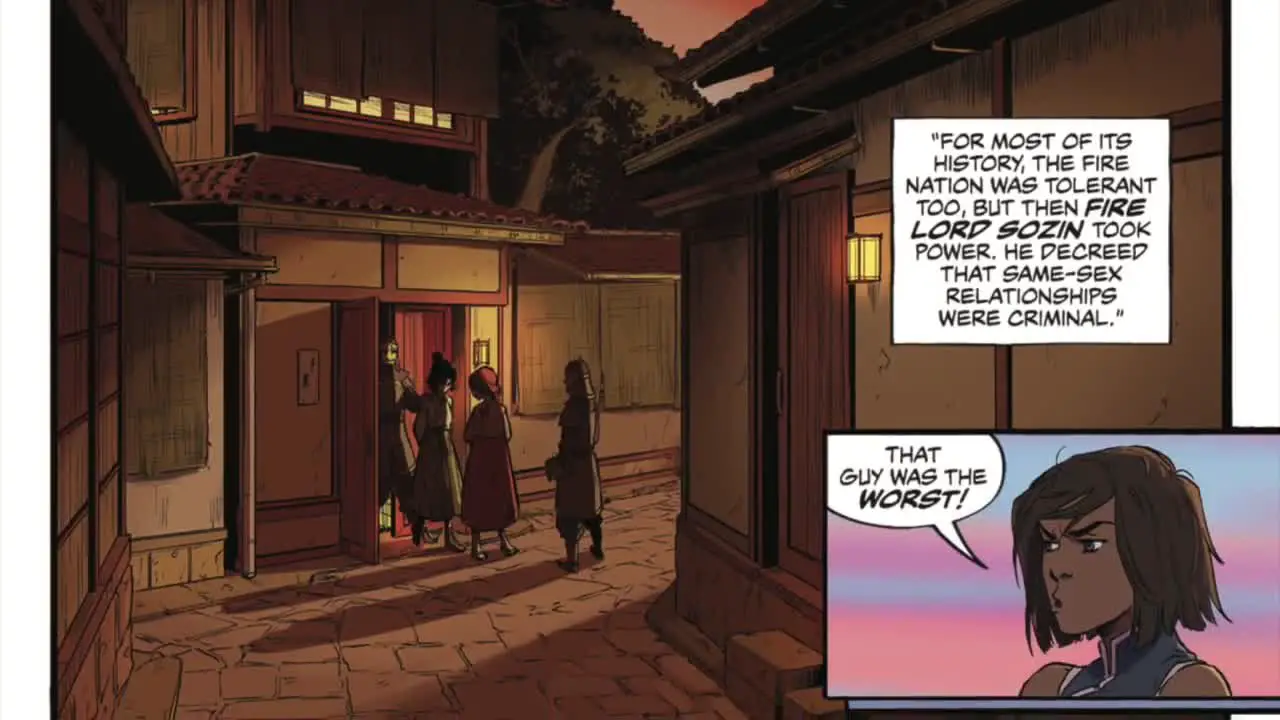The following contains FULL SPOILERS for Legend of Korra: Turf Wars Part 1
We are so stupid.
No, seriously, we—Griffin and Kylie—your infamously overzealous Asami (and Kate Kane) fangirls are two of the biggest idiots on the internet.
See, two days ago we dropped a review on Legend of Korra: Turf Wars Part 1, which we gave a 4/10. We personally felt frustrated by it, and actually found it somewhat offensive thanks to our own unique backgrounds and experiences. Though we did our best to explain why, while also trying to celebrate its net-positive in the world and acknowledge its validation of other readers, we kind of got lost in an overjustification for our reaction and forgot to explain one crucial thing: we actually liked it. We just…forgot. Kind of.
Yeah, yeah, we know what this sounds like, but hear us out.
We should have made it clearer on Wednesday, but the place we were coming from was nothing but overenthusiastic love for this franchise and all of its characters in it. We’re not sure it’s possible for us to have thought about this world as long as we have and as in-depth as we have without coming to adore every aspect of it. So when we saw one page—just one page—that in *our view* not only derailed the entire quality and messaging of the comic, but also clashed with the world on a fundamental level, it was kind of…all we saw.
It’s difficult for us not to. For one, and we’re sorry but you’ll have to allow us a good deal of personal bias here: the page we’re talking about? It’s the one that introduced institutionalized homophobia into the world. The one where we found out that Kyoshi never elicited lasting change, and the one where Nazi imagery was explicitly and purposely evoked to show how queer individuals had been persecuted in the past.
We’re jews, okay? It’s impossible for us to look at people being led out of their house in handcuffs in the middle of the night by soldiers heavily evocative of the Gestapo, likely to camps, and not connect it to our people’s history. We’d both have gotten pink stars, you know? So this was viscerally upsetting for us to see and think about as now being a part of the Avatar-verse.
We know that this is our own personal reaction, and there’s really no way we can explain how culturally abhorrent this is to us to a point where it would be compelling to others at large. Not that we think anyone who doesn’t have the same reaction has any sort of moral failing, of course. Just a different frame of reference. We also don’t claim to speak for all jewish people, nor would we criticize any jew who didn’t feel as strongly as we do; for us, it simply came at a really really really bad time. Not that any time is a good time for Nazi imagery, but now specifically is pretty bad.
However, if we can move beyond that inescapable baggage, there was another thing about Turf Wars that slanted everything in the negative review you read. We don’t think it fits with the canon of the shows. Like, at all. And yes, it’s still because of that one page. Because this isn’t only homophobia on a case-by-case basis. If it was simply a general warning from Tonraq without having seen institutionalized oppression, that would be fine. It might not have been our penchant, but it would have been fine. Good, even.
The thing is, with that page, it’s still fine (minus the Nazis)! It’s just not grounded in the franchise’s canon. So our entire frustration was because we couldn’t articulate that while we like this comic in a void, we don’t feel this aspect worked and personally view it as something disconnected from the main canon. We also do still believe that a comic could have been produced that would have been just as validating and positive that also fit within the universe, so the harshness of the review is partially because of that. In short though: rip out the page, it’s all fine, and we could all be enjoying ice cream together.
Instead, we recommend you order yourself a nice pastrami on rye (with brown mustard of course), because we need to neurotically explain why we don’t view this as fitting in the Avatar-verse, and we really don’t want you to go hungry. Seriously, eat. And we’ll even throw in some Seinfeld jokes in our efforts to entertain you.

One more thing before we dive in. We want to emphasize that everything you’re about to read are simply conclusions we came to. As two random nerds on the internet who hold a little bit too much enthusiasm for finer business details and the politics of fictional settings. That’s it. That’s who we are. If you come to different conclusions, or land in a different place, we’d love to hear about it and discuss it with you. Even though we want to keep the tone light, we do view this as a really important topic, and something worth discussing in full. If we’ve ever written something that conveys a different attitude, we offer our sincerest apologies. We hold zero ill-will for anyone who disagrees with us about any aspect of the comics, Avatar, or really anything ever.
Except Nazis. Fuck those guys.
“Not that there’s anything wrong with that!”
Yes, this whole piece…it’s about the homophobia. It’s about the fact that Korra and Asami were cautioned about telling the world they’re dating, along with the exposition dump by their friendly neighborhood Font of Gay Knowledge, Kya II. We already tried to briefly explain why there can’t really be this prejudice in this world on a systematic level (and why therefore it eminently frustrated us), but we’re going to go into full detail now.
See, throughout Avatar: The Last Airbender (ATLA) and The Legend of Korra (LoK), there *were* moments here and there, where we saw characters being sexist or making gender-based comments. So we don’t want to pretend that this world is completely free of prejudices beyond the obvious foregrounded ones surrounding nationality and bending abilities.
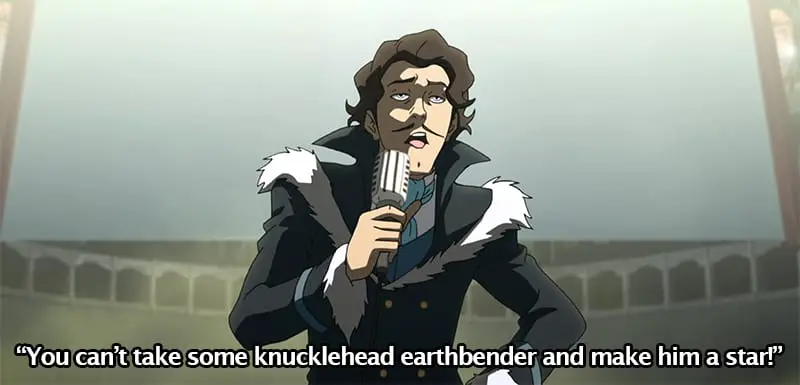
When it comes to homophobia, the root of this prejudice is sexism. The backlash against two people of the same gender entering into a romantic relationship directly relates to their lack of adherence to the prescribed societal gender roles. In a patriarchy, women are oppressed, with men as their oppressors (this is speaking quite broadly, of course), and the enforcement of that hinges on compulsory heterosexuality.
The thing about sexism and homophobia, or any prejudices for that matter, is that there doesn’t necessarily have to be malicious intent for it to exist and be enforced. Sokka saying that women shouldn’t be fighting and are good at sewing was an example of what we’d call “benevolent sexism.” It’s nicer than him saying “[gendered slur], make me a sammich,” but it’s derived from a protective paternalism, which is infantilizing and restrictive to women.
Where homophobia fits in is that there are three general “subfunctions” of sexism, or rather, functions that serve to enforce sexism:
- Paternalism: women are viewed as less-developed, and thus in need of protection (at best) or having decisions made for them
- Gender differentiation: the assumption that biological differences between males and females justify adherence to set gender roles
- Heterosexuality: ranging from tropes based on a desire for intimacy (at best) to fear of women attaining power through their exploitation of sexual attraction
This framework is known as “ambivalent sexism,” because it can manifest in both benevolent and hostile ways. Let’s break it down:
- Protective Paternalism (benevolent): men should care for and protect women
- Dominative Paternalism (hostile): men should control women
- Complementary gender differentiation (benevolent): adherence to traditional gender roles for women is important/needed by men
- Competitive gender differentiation (hostile): men are superior to women
- Intimate heterosexuality (benevolent): women are sexually pure and romantic intimacy is necessary to complete a man
- Heterosexual hostility (hostile): women are sexual objects for men’s benefit, but should be feared in their capacity to manipulate men with their sexuality
Homophobia should really be thought of as “heterosexism.” It cannot exist in a void from wider sexism, because it’s a gender-based prejudice. It’s also something that exists in smaller, more insidious ways. Ever joke about a guy being “whipped” by his girlfriend? That’s some (admittedly benign) heterosexual hostility there, which stems from the anxiety of a man being subordinate to a woman. It’s also dominiative paternalism and complementary gender differentiation. What fun!
“But wait, Grifflie,” we’re sure you’re saying, “There was sexism in the Avatar shows, so all this still works. You are defeated!”
We know, Jeffrey. Just give us a chance, because we’d love nothing more than to go through the cases of sexism in these shows, which are as follows:
1.) Sokka had some very weird views about women, until the Kyoshi Warriors explained his sexism away in 30 seconds of screentime.
To be perfectly honest, we’re just as confused where Sokka’s sexism came from as we are about his literacy and advanced knowledge of physics. As far as we could tell, he was the sole teenage boy in a rather isolated village where the women were running things. You’d think that would have led to him being a bit more open-minded about their roles in society and his personal conception of strength.
Still, it’s true that it was the men of the Tribe who went off to fight the Fire Nation, probably because there were no benders in the South so fighting physicality was a factor. It’s not rare to see wartime necessity create gendered roles like this, even if we think Sokka’s “haha women are useless” attitude is a bit of a stretch. But in fairness yes, it actually makes sense for there to have been a degree of protective paternalism in that situation. In fact, that’s more or less exactly how Hakoda framed everything to him when Sokka had wanted to go fight:
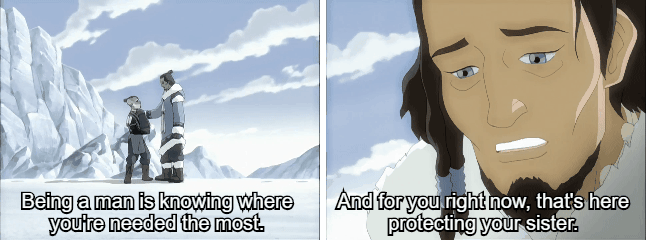
It equally makes sense that Katara hated and pushed against Sokka’s attitude, finding it infantilizing and quite the broad-brush mentality. We’ve kind of rationalized the way it manifested in him as a result of Sokka having no frame of reference with no other men around. To him, if he’s shitty at sewing, it must be because women are better. And he hasn’t seen any female fighters, so they must not exist!
We’re glad all it took was him meeting a girl that wasn’t his sister to come around. It was blindingly clear that this is attitude wasn’t accepted on a larger scale, probably because the other men understood the importance of the women’s roles during the war (even if they were gendered in the assignment). So of course by LoK, the Southern Water Tribe is run by a Council of Elders, and women can casually participate in poorly-conceived rebellions if they so choose.
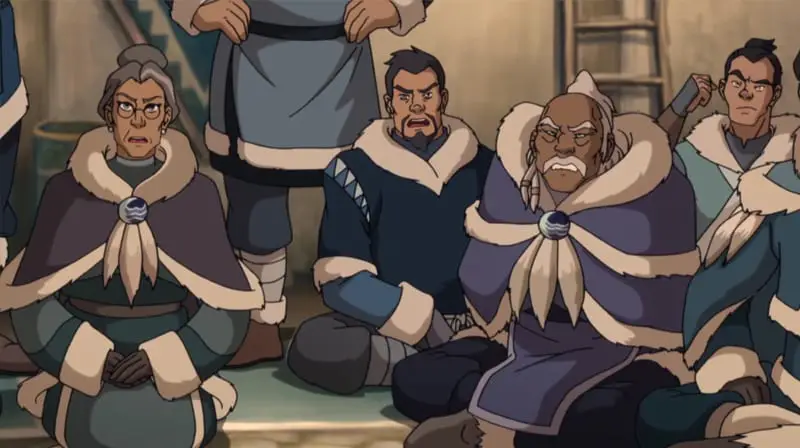
2.) The Northern Watertribesmen were sexist asshats (and Katara punched them)
In this case, there is actually quite a good reason for why there was institutionalized sexism: the dichotomic nature of waterbending. It can be used for both healing and fighting. Probably as a result of the time of war, there was some heavy protective paternalism that led to those roles becoming gendered in practice.
Wait, should we explain this more? We don’t want to get too in the weeds here, but women have babies and then typically care for said babies, so when there’s an external threat, this is when the maternal role is more encouraged to protect the longevity of a culture. The sister tribes both subscribed to this during the Hundred Years War, from what we can tell.
Katara tried to decapitate the patriarchy Pakku, and it made him realize that perhaps those womenfolk can fight and should at least have the option of learning both aspects of the bending discipline. Also his hopes of reaching first base had died because Gran Gran didn’t like their stupid patriarchal arranged marriage system. It’s not a shock that it went away right after Katara pointed this out to him, immediately followed by the crown princess breaking down into sobs over how much it sucked for her too.
Of course some remnants of this patriarchy remained, like the bethrothal necklace system, but there’s no indication any sexism stayed particularly intact on a structural level beyond that. By LoK, not a single person second guesses Eska co-ruling with Desna (even though they should have, because MONarhcy), the most terrifying waterbender we meet is Ming-Hua who is taken very seriously by everyone she encounters, and male healers are rather commonplace in Republic City. There seems to have been a clear breakdown of those wartime patriarchal roles within the Water Tribe. Thanks, Katara!
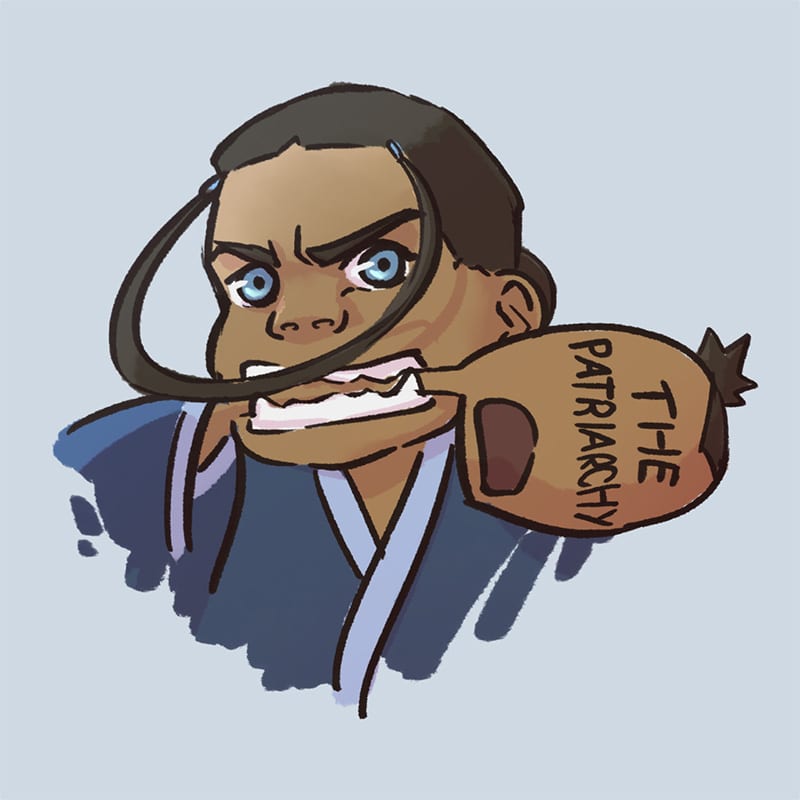
We should point out Korra’s throwaway line at Bolin about betrothal necklaces, since it gets tossed out a lot when this topic is brought up:
“I’m pretty sure the guy is supposed to give the girl the betrothal necklace.”
We don’t think this comment of Korra was her shaming Bolin for not fulfilling the proper gendered duty, so much as finding amusement in the situation with her creepy cousin, and potentially the entire betrothal necklace practice. Hell, Tonraq’s from the North and he didn’t bother foisting one of those dumb things on Senna (or if he did, she rejected it). Really not suggestive of anything grander here.
3.) The Fire Nation/Earth Kingdom Soldiers/Generals/etc. were all male & same-gender couples were never shown on screen
We admit, this was an issue in the show at points—most notably the start of ATLA. Ozai’s entire war council, there’s every Earth General we met, every single background soldier in Book 1…were there even female Dai Li (not counting the Joo Dee’s)? But the way we look at this is that it’s more of an issue on the production-side of things than any actual intentionality within the narrative.
See, as time went on, women just started casually popping up in the background. There’d be female Fire Nation soldiers serving as guards, and we had the intentional foregrounding of the Kyoshi Warriors as a major fighting force within the Earth Kingdom Forces. This isn’t touching Azula’s squad.
If we ignore that change in pattern and say that in this universe, fighting and military strategization are typically viewed as the men’s jobs, we still struggle to see paternalistic practices like this entrenched anywhere else. Women are not denied access to political participation, nor are they even particularly denied access to fighting if they demonstrate an interest. Even the prominence and clout of characters like Li and Lo paint a broader picture of the general acceptance of, and respect for, female authority figures.

LoK was light years beyond ATLA in its representation of women in power, from the United Republic Councilwoman in Book 1, to the Earth Queen, to Fire Lord Izumi, to Lin, to Suyin, and of course, to Kuvira. (We’re leaving Korra out since her figuring out her role as a leader to the world was, you know, the entire story.) No one ever questioned their authority on the basis of gender, because why would they? Whatever institutional barriers the background male soldier models might have implied, it is simply not in evidence anywhere else given how female characters are treated and advance in-verse.
Not to mention, having all male background models was a well-documented problem, to the explicated chagrin of showrunners Bryan Konietzko and Michael Dante DiMartino (Bryke).
“I made a point of having several female officers of all different ranks designed for Kuvira’s military. Unfortunately, for whatever reason, they were largely left out of the final animation. I didn’t supervise the background character assigning, but as the art director I ultimately have to take the blame. So, I’m sorry! We made them, but you don’t see them enough. Sigh…” —Bryan Konietzko, Book 4 Artbook
The man literally typed “Sigh” into the artbook. So with this, and the way that the characters are actually treated, we really don’t find extrapolating too much meaning off of it to be particularly logical.
We should note that this is also the case for the argument that “there’s no same-gender couples on our screens, so that suggests oppression.” It’s not unreasonable or anything, but again, this just seems to be the result of a restricted medium (or restricted imaginations of animators, at times), than established societal tensions. We know that Bryke perceived restrictions on openly depicting a romance between Korra and Asami in 2014. In fact, it wasn’t just a perception:
“We approached the network and while they were supportive there was a limit to how far we could go with it, as just about every article I read accurately deduced.” —Bryan Konietzko, “Korrasami is canon“
So yes, ATLA and LoK were both restricted in terms of the open depiction of same-gender couples. This is because they were both Y-7 cartoons that also aired internationally, in countries with very strict rules on this. Korrasami was considered “groundbreaking” for a reason, and it’s only been since then that we’ve seen that “significant inching forward” continuing in children’s media. Mostly thanks to Steven Universe. (Come on, Adventure Time, work with us!)
Given the hoops Bryke jumped through just to make sure we could have a Korrasami hand-hold, we don’t really view the lack of background couples or explicit mentions of non-heterosexual proclivities as anything other than a reflection of the reality of the times in which they were produced. Again, we view it as more reasonable to examine the treatment of the characters on the basis of gender to determine where the society would land on its acceptance of same-gender couples. In other words, we’re dismissing a Doylist issue within our Watsonian framework of analysis.
4.) There are sometimes gendered jokes, comments, and advances
Okay, this stuff is difficult, because these kind of things aren’t really about institutionalized sexism. If we’re talking about a pervasive overarching societal attitude, well… past Iroh (sometimes), Sokka, potentially Tahno (was that necessarily gendered?), Meelo, and Grandma Yin, does anyone else subscribe to even a vaguely sexist mentality?
Prince Wu can be creepy, we suppose. He did call Kuvira “pretty easy on the eyes, for a military type.” But did anyone give him the time of day? Didn’t he get shut down over and over by literally everyone in the narrative, including right in that moment?

The worst sexist attitude we can think of besides Sokka (for four episodes) was Uncle Iroh, since he creeped on June the bounty hunter, and also gifted Azula a doll when he gave Zuko a knife. We don’t really have a lot of answers for the June thing other than “this isn’t a joke Bryke thought through.” Don’t touch victims of paralysis without their consent, okay? We can also think of several reasons why Iroh might have been hesitant to give his turtle-duck-mauling niece a knife to play with, but if the idea is that Iroh is *sexist* and it’s reflected in *society* we just…don’t really see support for this, for the character or the setting.
Overall, Iroh took the threat of Azula quite seriously, and never had a moment of hesitation in accepting the competency and capabilities of Katara or Toph. Was this an about-face at the end of Book 2 because he was humbled by Azula accomplishing what he failed at for 600 days in under a week? If so, thanks, Azula! But more to the point, the larger pattern of Iroh’s portrayal is not one of a dude who’s got prejudicial attitudes towards women.
For the setting, you know…see points 1-3. Or think back to shows we watched and the treatment of women within them. A single old creep does not a sexist/homophobic society make. We truly don’t recall Korra being the recipient of a single sexist remark, with the one possible exception of some octogenarian telling her that she was “muscular for a woman.”
WHICH SHE IS. Thanks to nonbenders being more prevalent than benders, there’s probably “typical body types” that fall more into what we’re used to seeing in our world, so the comment makes sense. Korra being so muscled is likely a rare case when it comes to benders too, now that we think about it, since they don’t necessarily require that kind of physique. Remember this?

Plus, up yours, Granny.
We also need to say something that we’re a little hesitant to bring up: these shows were penned by two American dudes (and a few other helpful writers) in between 2004 and 2014. We’re not trying to “death of the author” anything (we actually think people misuse and overuse that concept), but there is the Doylist reality that they’re contemporary authors writing for a modern audience. This is speculative fiction, and we think Bryke did fabulously overall at creating such a consistent world that feels quite real. But on occasion, there’s jokes and one-offs that aren’t the most organic, nor do they fit within the larger pattern of the shows.
Meelo being an incorrigible little jerk who doesn’t answer to any “girl” is one of these examples. Though we should note he also doesn’t answer to any “man”, by his own assertion. We think Meelo has a lot of red flags, most of them having nothing to do with anything gendered (he weaponized the entire lemur population of an air temple). But in general, forgive us for not reading too much into his scripting, since it literally affects nothing, he’s shown completely respectful of Korra’s authority without the slightest hesitation (yet not Bolin’s), and no one even particularly reacts to him. Who’s leading the airbenders after Tenzin fails over and over? Jinora. Obviously the Air Nation isn’t walking whatever talk Meelo’s going on about.
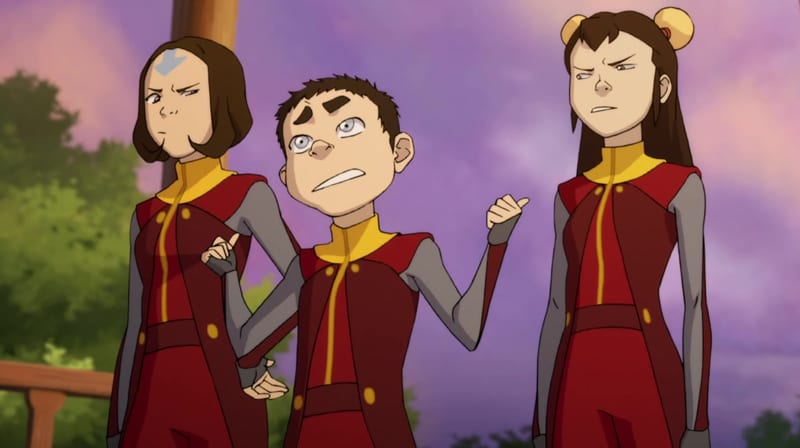
And that’s it! That’s the sexism in the shows!
Let’s talk about egalitarianism, now. (No, sit down, Amon.) See, we can’t list every example, because it’s the fiber and structure of the entire Avatar-verse.
We said this before, but take things like the random female Fire Nation prison guard in ATLA, or how no one said anything when Azula became Fire Lord. Or when Izumi was. Or when there was queen in the Earth Kingdom. Or when Suyin built her own matriarchy. Or when Toph single-handedly created a modern police force and multiple statues of herself just because she could.
Our point is, women are just like…there in this universe. They’re not even treated any differently, barring the few exceptions we described above.
Therefore, it’s the pattern we have to take into consideration for the worldbuilding. Because seriously, where was the negative feedback on the basis of gender for Toph, or Katara, or Azula, or Korra, or Asami, or Avatar Kyoshi, or Earth Queen Hou-Ting, or Suyin, or Lin, or Kuvira, or Jinora, or literally anyone?

It didn’t exist. Any character who said something sexist got immediate, negative feedback, or was ignored, because that’s super weird of them. They were outliers, because sexism is not institutionalized on any level in this universe, with the exception of the Water Tribes during the war.
There’s a really good and logical reason for why sexism isn’t systemic, by the way. You see, this world has a spiritual leader with the powers of a demigod, and the ability to bend space, time, and everything else. They look to this person as a kind of Dalai Lama-esque figure (or Pope, if that’s more your understanding). And there’s a 50% chance that it’s going to be—wait for it—a woman! Sometimes a woman who lives for 230 years, murders her foes without hesitation, and establishes the laws and structure for the largest nation on the planet.
We are, of course, speaking of Avatar Kyoshi who, in a comic was revealed to have established the Dai Li. Yes, we believe show canon trumps comic canon, but when comic canon works and expands logically based on the established rules of the source material, we will point to it and gladly champion it.
Either way, this was the role model for the world for over two centuries:
Kyoshi: Chin the Conqueror threatened to throw the world out of balance. I stopped him. And the world entered a great era of peace.
Aang: You didn’t really kill Chin. Technically, he fell to his own doom because he was too stubborn to get out of the way.
Kyoshi: Personally, I don’t really see the difference, but I assure you, I would have done whatever it took to stop Chin. I offer you this wisdom, Aang: Only justice will bring peace.
What structural sexism could exist with this history? Especially when her male predecessor was a moron who got himself killed at thirty fighting his spirity white whale when his girlfriend got her face stolen. Yeah…we really have to scratch our heads to figure out who would have been more inspiring to the people of this world.
So about that homophobia (heterosexism)… It’s not that we couldn’t imagine a joke here and there, or some confusion by people who aren’t particularly good at looking outside their own experiences. There’d be gal-palling, for sure.
But when you have a world where women have such a high degree of autonomy and social mobility, that goes hand-in-hand with sexual autonomy as well. The whole thing with heterosexism—be it benevolent (intimate) or hostile (competitive)—is that it rests on the notion that women exist for men. Homosexuality is distressing for [hetero]sexists, because it allows women to escape their roles in relation to men, while gay men neglect their duty to uphold their dominance over women.
But…there’s no societal dominance that men have over women in this world to be upheld, at least not on a broader scale. If there was, we couldn’t have had characters like Toph or Kuvira get the general reception that they did: full acceptance and respect.

With this, the idea that Korra—the current spiritual leader, who saved the world on multiple (and heavily publicized) occasions, including an instance less than three weeks prior to the events of this comic wherein she ripped open a portal to another dimension in the middle of the world’s cultural hub—would be hesitant to live openly because she’s dating someone who happens to be a woman is beyond absurd. Even when she was polling at 8%, this would be absurd.
We’re not sure about -3% though…that’s Raiko’s problem.
Please, tell us how the concern over Korra not being accepted fits with the world we just described. Who would challenge her? Who would be stupid enough? And how would the potential for that feedback be great enough that she actually needs to navigate cautiously? What are she and Asami in danger of, exactly? Also if this had been such an issue, wouldn’t Asami have exhibited slightly less than the extreme thirst for Korra that we witnessed in Book 3? Girl was heavily flirting, regardless of who was watching (right, you go find those airbenders ~~in style~~). Acceptance didn’t register as even a vague factor here.
This is not a case of “oh, we wish this story wasn’t being told.” We’d have rather it wasn’t, for sure. But for us, the story does not work on a fundamental level, and we find that it falls apart when placed under scrutiny, especially given how entrenched the homophobia was described in the Earth Kingdom and Fire Nation.
In fairness, we could see a degree of heterocentricity, perhaps just because straight couples are more commonplace (which…because…babies). In that vein, sure, characters might not immediately realize Korra and Asami are together. But other than that…no. Just no.

“It’s like an onion, Jerry.”
That is the background. That is why, in a general sense, homophobia cannot exist on an institutionalized level in this universe, and certainly not to a degree where the spiritual leader would feel unsafe being openly bisexual.
Yet homophobia was introduced in this comic—more or less immediately after Korra and Asami returned to the “real world.” (As an aside, we’re really not fond of *that* particular messaging.) Tonraq cautioned Korra from telling the public about her relationship, because people might not be accepting. In fairness, we appreciate a father telling this advice to a daughter in a world where negative feedback is possible, like ours.
This thread continues, and Korra and Asami keep their relationship under wraps once they get back to the city, Korra even conceding that her parents have a point, and Asami telling Korra that what they have isn’t likely to be understood by the world at large. Again, for the reasons we’ve explained, we cannot accept this as fitting with what we know to be canon, since it goes against the setting’s foundation.
However, the way they went about explaining its existence was nothing short of bemusing.

See, if you twisted our arms and said that we had to include homophobia on a broader scale in this universe, we would fight you, but ultimately concede that okay…okay. If we had to, then in a certain context, the Northern Water Tribe could still be a bit unaccepting, perhaps a la America in 2014 before there was marriage equality. Nothing too horrible, but maybe not perfect protection under the law. We could even see some heterosexism as having been a part of the Air Nation’s history as well, given their gender-segregation and strict/probable-ascetic lifestyles. We’re not saying this stuff is likely, or makes for the best story, but it wouldn’t be too far a stretch. However, we’re mad at you for making us do this, and please let go of our arms, because we’re very sensitive.
Instead, Kya Mike expo-dumps with the following:
- The Fire Nation was completely tolerant for “most of history,” but then everything changed when Sozin went full Gestapo and randomly decided to outlaw gay relationships to the point where people were getting rounded up in the night to be taken to who-knows-where
- The Earth Kingdom had a fair amount of homophobia, so Avatar Kyoshi, who loved both men and women, never found acceptance because her nation was the “slowest to change” and the “most militaristically repressive”
- The Air Nation didn’t care in the slightest. Free love!
- The Water Tribe likes to keep family matters private, and even though coming out wouldn’t ruin anyone’s life, they advise against it, even today. Don’t Ask, Don’t Tell!
To put it bluntly, we find all of this incomprehensible given what we know from ATLA and LoK. Literally everything is backwards.

Okay, mostly backwards. We suppose a ~free love Air Nation~ makes some sense, especially because these were the guys living in gender segregated temples—there’d be some canoodling, right? But from what we know, monastic lifestyles don’t typically lend themselves towards progressive ideals or freedom of [any] sexual expression, especially when there’s already heavily gendered roles in place. This can work, in a super idealized kind of way. Though like we said, if there’s a nation where full institutionalized homophobia might make some sense, it’s here.
The description of the Water Tribes is more confusing. We wonder if Mike remembered that the Water Tribe was you know…a tribe. Family units are almost always deemphasized in such society, and we know they were in the Southern Water Tribe during ATLA’s run, because we saw it. It was one village with everyone having a collective responsibility to one another.
We did mention how the Northern Water Tribe could maybe have some non-progressive views given their patriarchal practices at the very start of ATLA. But to structure it around privacy and the family itself still doesn’t seem quite right, especially given the Inuit influences of the tribes. From our perspective, we immediately thought “oh, here’s the ‘Don’t Ask Don’t Tell’ nation.” Probably because it’s on our minds a lot. (Particularly this week, sadly.) Maybe that has a present-day value, especially since there are cultures with a similar familial insularity as described. It just felt out of place to us, within this setting.
And then it only gets exponentially worse. Because we get to that page that makes us want to, well…

Let’s start with the Fire Nation. We already explained that it was quite canonically egalitarian. Azula was treated incredibly seriously and respectfully by everyone she interacted with, be it the governor of New Ozai, or her ship’s captain. There were both male and female fire sages, women serving casually in the military (by Book 3 of ATLA, anyway), and there was simply no indication that a ‘Fire Lord Azula’ would have been met with a single eye blink. Heck, by Korra’s time, a woman is not just the Fire Lord, but decidedly in-charge of international politics. Izumi speaks literally two sentences in “Beyond the Wilds,” and that’s that. That room capitulates.
Look, homophobia can’t just spring up out of a hole in the ground, unlike dwarves. The root cause is sexism. So the implication here is that Sozin was heavily, heavily sexist, right? Because he can’t just be homophobic in a void. Even if he had gay-panic over his relationship with Roku and that’s what made him want to outlaw gay couples, it would be a gender-based panic (a fear of not seeming ‘manly’), so…sexism. Heterosexism!
But any systemic sexism was gone by Ozai’s time given what we saw in ATLA, so… Was Ozai a wonderful feminist reformer for the Fire Nation’s military? Was Azulon? He did seem pretty fond of his granddaughter, we guess. Or are we completely wrong and it’s still there, we’ve just never been shown it? After all, Kya didn’t say if gay relationships were legal again. We have to assume given what we know of Zuko and Izumi that they would be, but…when? Or is it possible that it’s still illegal, since there’s such bad homophobia that Kya, Aang’s 60-year-old daughter, still is hesitant to tell others about her sexuality? Are gay couples somehow targeted without women’s rights being an issue at all? We certainly can’t think of many examples in our world where this was the case.
It just…none of these possibilities make a ton of sense.
And okay, maybe we can rationalize it by saying that Sozin’s Magically Appearing Patriarchal Practices™ were actually implemented because he wanted a lot of Fire Nation babies, so therefore non-procreative couples wouldn’t be very helpful to his Imperialist aims. It wasn’t especially about homophobia as much as pragmatism.
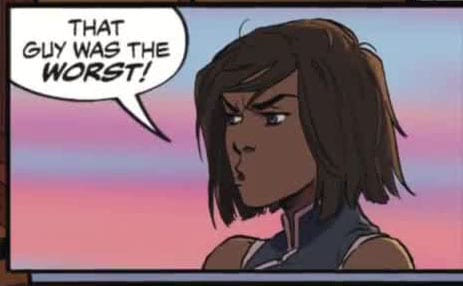
Except this is literally the least efficient way to get a population to follow you. He was trying to wage war on the biggest kingdom; he was seriously going to begin oppressing his own citizens, all of whom would probably take issue with his out-of-the-blue hyperfocus on gay couples? What, had he been scapegoating them for years, laying the groundwork? Kya said relationships were outlawed as soon as he took power (well before the war), so…was this part of that strategy? Did Roku not notice? Like, it’s so bad that the comic showed us people being grabbed in the night, probably to be led off to the gulags or something. Kind of an oversight.
More to the point, if this shit was happening, there would be rioting! Civil Wars! At the least, wouldn’t some people have resisted these orders, especially because using resources to do this during a massive global war isn’t exactly easy or strategic? Even if we’re really, really generous and equate this to World War II and the holocaust happening together (we just love when our media reminds us of that for a quick puppy-kicking moment!), we refuse to believe that this wouldn’t have been an issue EVERY SINGLE AVATAR would have dealt with until it was fully rectified.
Which yes, we know that list is just Roku, Aang, and Korra. But even with Roku being unable to stop Sozin and Aang being frozen, when The Hundred Year War ended, had the targeting of a vulnerable population occurred to this degree, wouldn’t Zuko and Aang have made a point to liberate the arrested, while also working to promote tolerance and begin a healing process? Maybe they would have even rewritten the Fire Nation’s constitution to create protections against anti-gay rhetoric, and to implement a system of checks and balances whereby a fascist would never again be able to turn on his population like…wait, sorry, that was Germany.
Even accepting the premise that Sozin was just a shitty leader and completely insane, (which…yes he was, though to the meta-degree of fixating on a new prejudice?), we’re still left with the questions about feminist-reformer-Ozai, who went on to champion his own daughter (and a younger sibling to boot) as his successor, so…? #ItGetsBetter? Then why can’t Kya be out? Or Korra!
Also, did we seriously need another reason to hate Sozin? He’s a genocidal maniac who was conquering the world. Adding on a contemporary negative trait just feels lazy, especially since we were told everyone in the Fire Nation had been accepting before this. It’s like if Kya then went on to explain how Sozin also hated the Jews. That’d be bad for sure, but boy does it not rise from the setting. At least we had Korra telling us “he’s the worst,” or we might not have known what to think.
Oy yoy yoy. Earth Kingdom time, and here is where we lose whatever chill we had.

“Even Avatar Kyoshi—who by all accounts loved men and women—was unable to effect any kind of real progress. After all, the Earth Kingdom has been the slowest to accept change, and the most militaristically repressive.”
Yes, the Earth Kingdom is massive. Absolutely 100% the most difficult to reform. Credit to Mike where credit is due. It’s overrun with orphans (oh hai, Kai), centralized power is completely useless outside of Ba Sing Se, there’s roving gangs of teenagers living in trees (oh hai, Jet), and Mad Max bandits just seem to exist, everywhere. Fuck, the Earth Queen couldn’t even collect taxes without Korra’s help! This is why Kuvira had her work cut out for her. How do you possible unify and modernize a nation of this size, and do it in a way where progress sticks?
So with that, please explain to us how this land was the most militaristically repressive? Jet didn’t seem particularly militaristically repressed. Omashu had its own king until the Fire Nation came in and militaristically repressed it themselves. Sure, heavy military control was the case for last three years of canon in LoK, but you can bet your bottom yuan that Kuvira wasn’t prejudiced towards *the gays* and using her military to make their life difficult in any way. She’s a ruthless pragmatist (no Kuivra apology, please) and took every body she could find. Except those damn immigrants.
Besides, the homophobia that Kya is talking about was before Kuvira’s time. And we’re told that it was so bad, the 7-foot-tall 230-year-old demigod who destroyed Chin the Conqueror and created peace in the Earth Kingdom by stopping peasant revolts never found acceptance in her own home.
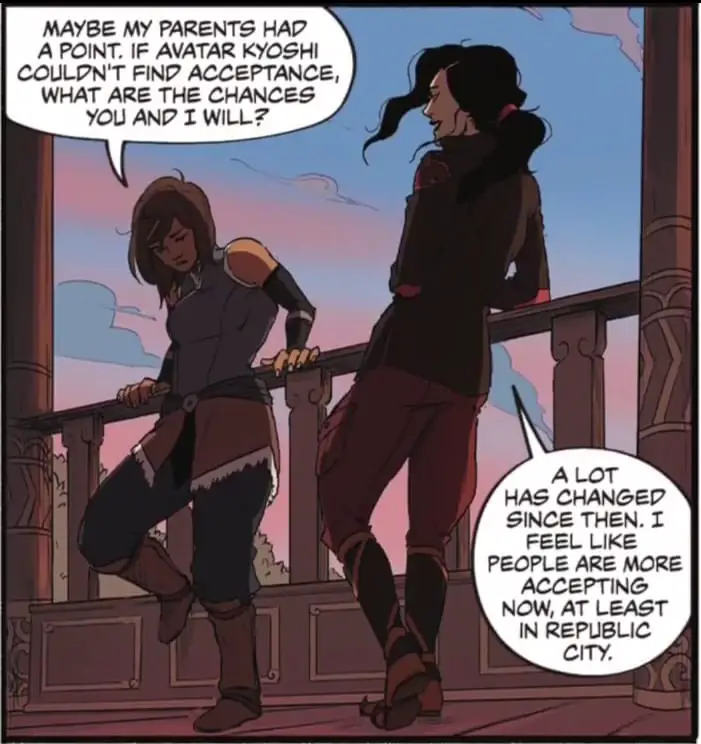
There’s just so many issues with this.
First of all, even if the Earth Kingdom had been the most militaristically repressed (which it wasn’t and that’s why Kyoshi had to stop Chin by herself in the first place…the problem was that the military was useless), Kyoshi is the person who established the Dai Li and literally took control of the military. If there had somehow had been homophobia present on a large scale, we can’t imagine that Kyoshi, being queer herself, would have allowed this to continue. In fact, wouldn’t she have used the Dai Li to eradicate it, at least to the point where she could find acceptance? It’s Avatar “only justice will bring peace” Kyoshi. She would have had the Dai Li murdering and brainwashing homophobes if she had to, especially since this is something that was threatening her people and the stability of the nation (if she couldn’t find acceptance, how was everyone else possibly faring?). Which is exactly what the Dai Li are tasked in protecting!
You know…prejudice is not very good for a sustainable society. Just saying. We assume Kyoshi would know this, since she created an island just to ensure the protection of her people from some asshat with a Napoleon Complex. It’s very difficult for us to accept with what we know of her that she’d just stay there the rest of her life, tail in between her legs. Especially when she more or less created the entire governmental structure for the damned Kingdom. It’s not like she could have made every single person in the Earth Kingdom accepting, but we have to imagine she’d be able to have influenced the laws and protections to at least have “found acceptance” and “effect change.” Especially being the spiritual leader of the world.
Secondly, you can’t have a nation be both the slowest to change and the most militaristically oppressed. This is a contradiction. Guess what happened when Kuvira oppressed the Earth Kingdom with her military? There was immediate, sweeping reform. She updated the entire infrastructure in a three-year time span, to the point where it became more advanced than the United Republic in many places. (Thanks, Varrick!) Heck, she even reformed everyone’s haircut! This wasn’t slow change. Pick one, Mike, but you can’t have both, sorry.
But the problem is that you can’t pick one and still have institutionalized homophobia exist to the degree where Kyoshi didn’t find acceptance. See, if you pick “most militaristically repressed,” then Kyoshi sweeps across the nation with an army of her own personally trained warriors and terrifying officers, eliminating any institutionalized injustice root and stem. If you pick “slowest to change,” then we have to go back to how it’s depicted in the show up until Book 4 of LoK: completely decentralized, with different factions that are basically autonomous. See the matriarchal city-state of Zaofu for more detail.
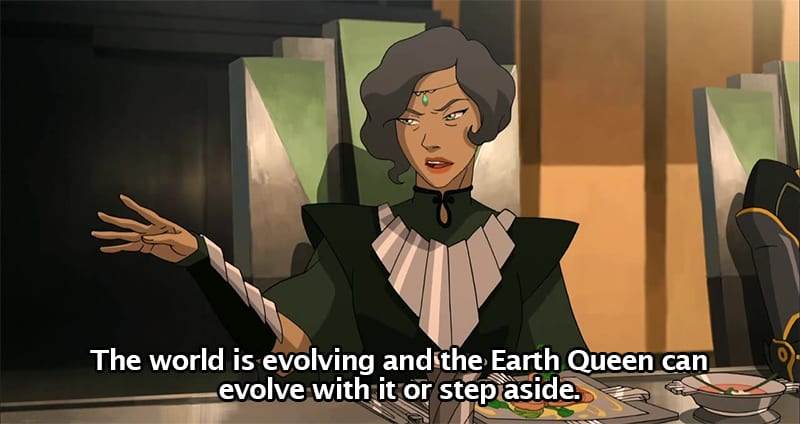
There literally can’t be large-scale and widespread homophobia in a place with such an ineffectual centralized government. There could maybe be a region that cracks down on it in a Chechnya kind of way (that is, if it was led by someone similar to Sozin), but it’d be a huge outlier—certainly nothing threatening to Korra and Asami being open about their relationship in a completely different country. And you think that shit would have scared Kyoshi from “finding acceptance”? Or that she couldn’t have made “real progress”?
Do we even need to talk about the beloved Kyoshi warriors? The Kyoshi warriors that even the entire Fire Nation seemed to know about, since Azula used their uniform and credibility to walk right into Ba Sing Se’s throne room and take over the country in a bloodless coup? It’s just… There’s nothing to indicate Kyoshi failed to find acceptance for who she was, and plenty of evidence to the contrary, since she is remembered quite fondly and her legacy continues as one of the most celebrated Avatars—that one weird village from “Avatar Day” notwithstanding.
But wait, there’s more! Because thanks to that one page, we started thinking more about Kya. This is something we absolutely wouldn’t have even considered had this page not existed but, why is her queerness even semi-private at all? Why does Kya…you know, daughter of Katara and Aang, 60-year-old, fought Zaheer to a standstill…even have this concern in the first place? Well to us, given what follows when she admits this, the implication is clear: she fears being out. In the same way it’s a very valid choice for people in our world to fear being out, or to be cautious about who is told. Things can be horrible, and downright dangerous.
The issue is that with a (mostly) closeted Kya, it means the Avatar-verse is actually worse than our own world. She’s like a celebrity (secluded acolytes with Air Nation blinders on excluded). She’s the daughter of one of the most famous people who ever lived, ever. Two, actually (though where’s Katara’s statue?). Okay, we’ll give you that we could have been overstating the egalitarianism of the world, but this is just ridiculous.
Even ignoring any special celebrity status, are we seriously expected to believe that Aang would have let his daughter feel unsafe to be herself? We’re expected to believe that Katara—KATARA—would have let such an injustice stand?

Also, at this point in time, who is going to judge Kya? Is it still off to the gulags in the Fire Nation? Are Water Tribe people still squicked by hearing about it? Kya sort of implied that. Is the Earth Kingdom still militaristically repressed into not accepting queer world leaders? And then how can the city that serves as the world’s cultural hub be pretty accepting according to Asami, but it’s still a situation where the daughter of the world’s former and beloved spiritual leader cannot live honestly, at least not without major hesitation?
This cannot work. It completely counters what we know about the universe as depicted on ATLA and LoK, and worse still, it counters itself.

“I have a suspicion that he’s converted to Judaism purely for the jokes!”
There’s one more point about this whole homophobia thing that isn’t sitting quite right with us on a worldbuilding level. The thing is, the Avatar-verse is more or less built with East Asian and Inuit cultures in mind. The Fire Nation is loosely based on historical Japan, the Earth Kingdom is China, The Water Tribes represent Inuit populations, and the Air Nation stands for Tibet. They’re not perfect parallels, and we’re not trying to argue that this is a documentary that needs to be completely accurate to these countries’ and cultures’ societal structures. In fact, it shouldn’t be. This is speculative fiction.
That said, we have a discomfort about just plucking these “Eastern” influences, and then wallpapering over them with contemporary and more “Western” manifestations of homophobic attitudes. Now the “East” is not at all a monolith, no more than “China” even is, and we’re not saying the “West” has a monopoly on homophobia. Just…the way it was portrayed raised our antennas, and we did feel that it was worth some examination from a historical framework.
We decided to ask an expert. Luckily, our friend Sarah was available to provide us with some information. She holds a bachelor’s degree encompassing world history, classical studies, comparative religion, sociology, and gender and sexuality.
Here are her quick historical overviews of homosexuality within the cultures/countries mentioned:
China
Male homosexuality was present and noted in China well throughout its history, from the Shang when written records first emerged, to the Qing, which gave way to the short-lived mainland Republic of China, so much so that there were multiple poetic terms for such, including “the passion of the cut sleeve” from the Han Dynasty figure Dong Xian (also the name of a 1990 book on the subject by Bret Hinsch); “the divided peach,” derived from the Zhou Dynasty figure of Mizi Xia; “the passion of Longyang” (a reference to a prominent figure from the Warring States Period); and “southern wind,” arising from the notion that male homosexuality had been introduced from a mystical land to the south of China.
Chinese folklore had Tu’er Shen, a god whose sole purpose was managing the love lives and sex lives of homosexual men (do note that male and female homosexuality were considered entirely separate, and because of the comparatively reduced social status of women in imperial China there is much less literature about female-female sexual and romantic relationships). The subject of a legend circulating as early as the 16th century, the human Hu Tianbao, was deified after his untimely death as Tu’er Shen, the rabbit god, emblematic of male homosexuality, and his depictions are either that of a rabbit or of a man in embrace with another man. So strong and widespread was the legend that homosexual men were commonly referred to as rabbits when the Qing Dynasty was in its later years. Such reverence of Tu’er Shen, as well as descriptions of analogues for arranged marriages between men, is well attested to in Hinsch’s 1990 Passions of the Cut Sleeve.
On the female side of things, there existed in popular myth a “women’s country,” situated depending on the storyteller either on the southern part of the Tibetan plateau or on an unreachable island (please hold all jokes about the “cheap Chinese knockoff of Themyscira” until the end) populated solely by women, who ran the society, managed public affairs, and also had relationships with one another. Although the place was (probably) fictional, it does demonstrate that the idea of female-female sexual relationships was not out of all conceiving.
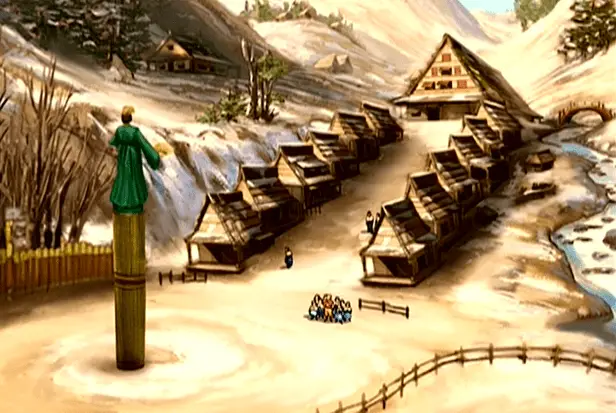
Japan
As in nearly all other matters, ancient Japan was hot on the heels of ancient China when it came to homosexuality. In Shinto mythology, the “invention” of male homosexuality, as it were, is attributed to two servants of the sun goddess Amaterasu, Shinu No Hafuri and Ama No Hafuri, rather than the “southern wind” popular in Chinese conception. Continuing with the matter of the gods, one of the most prominent events in Shinto is Amaterasu retreating to a cave after an argument with her brother, depriving the world of sunlight and warmth. To remedy this, the goddess of humor and dance, Ame No Uzume, gave a bawdy sexual performance to coax her out while the goddess Ishi Kore Dome (herself consistently depicted as transgender, as an aside) hung a mirror from a nearby tree. So enthralling were her own reflection and the dance that they were finally able to get Amaterasu out of her cave. One of the more apocryphal Shinto deities, Shudo Daimyojin, performs much the same function as the above-mentioned Tu’er Shen, managing male homosexual love and relationships.
On the more mundane side, the Japanese term for male homosexuality, nanshoku (男色), meaning “male colors,” is again well attested as early as the Heian period’s Genji Monogatari and courtier’s diaries from the same period as simply a matter of course. Additionally, the Chigo Monogatari (“acolytes’ stories”) has no shortage of descriptions of homosexual relationships between Buddhist monks and their acolytes alongside descriptions of heterosexual encounters.
Relationships not dissimilar to the pederasty of the ancient Greek city-states promulgated among the samurai class throughout the imperial period, and gradually grew to encompass relationships between men of smaller age differences (though the structural and educational components were retained to some degree). Male prostitution was far from unheard of, and there are bisexual and homosexual male main characters in Japanese literature from the late 17th century on (Ihara Saikaku’s The Life of an Amorous Man (1682), Ueda Akinari’s Tales of Moonlight and Rain (1776), etc.).
Inuit Tribes
There exists a smaller body of literature on the subject of same-sex relationships in Inuit culture, and while full-fledged relationships are not attested to, same-sex sexual activity was not unknown or spurned according to tribe elders, especially during extended periods of gender segregation (long hunting or fishing trips, for example). There are even direct, if lengthy, words for gay men and lesbians in the Inuktitut language: “anguteqatiminoortartoq” for gay men/male homosexuality (lit. “two hard things rubbing against each other”) and “arnaqatiminoortartoq” for lesbians/female homosexuality (lit. “two soft things rubbing against each other”).
Tibetan Buddhism
Tibetan Buddhist monastics (as opposed to simple laypeople) generally operated under some proscription of all sexual activity, including heterosexual relations, homosexual relations, and even masturbation, which would fall under nebulous and ill-defined term of “sexual misconduct.” Such restrictions are intended to limit the formation and importance of earthly attachments and promote a state through which enlightenment can be achieved.
Bear in mind though that the Air Nomads, who take their cultural inspiration from these Tibetan Buddhist monastics, don’t quite make sense as an entire culture unless there was an unseen laity responsible for maintaining the population; if the temples and monastics themselves were truly the extent of their civilization, then such restrictions may have been less stringent or simply non-existent.
***
Thanks, Sarah!
She did note that this information is readily available from just a few minutes of online searching. For those interested in further reading, she recommends the following:
- Cassell’s Encyclopedia of Queer Myth, Symbol and Spirit: Gay, Lesbian, Bisexual and Transgender Lore (Cassell Sexual Politics Series) (ISBN: 0304704237)
- Passions of the Cut Sleeve: The Male Homosexual Tradition in China by Bret Hinsch (ISBN: 0520078691)
- Male Colors: The Construction of Homosexuality in Tokugawa Japan by Gary Leupp (ISBN: 0520086279)
Now, this is one snapshot overview, we should point out. The fact is, the acceptance of same-gender relationships is something that’s never been stagnate in history, just like the actual forms of the prejudice. There was a really interesting conversation in the comment section of the review about “Eastern” views on homophobia and the way it’s shifted and manifested. What is clear is that there was, more generalistically, a contrast in viewpoint from the “West”, particular with personal vs. institutionalized oppression, even if today things look a lot different.
Things have changed over time. Even though it makes a ton of sense to us, reading in the 21st century, that Sozin would have been anti-gay because militaristic authoritarian movements are so strongly linked to that kind of persecution, that wan’t always the case. The “acceptance” of gay couples historically wasn’t particularly indicative of a “free and progressive society”, and any periods of crackdowns on homosexuality didn’t correlate to the relative tyranny of the ruler, either.
Again, there’s no one way this has ever looked in any culture across the centuries, and we aren’t saying there was the “accepting and tolerant East” historically, or that homophobia is absent in the East Asia today. There’s just…a different manifestation of homophobia across regions and time.
We didn’t need, expect, or even want a copy-paste of any particular historical depiction for Turf Wars. But it does seem as though DiMartino simply slopped today’s American mores onto a world based around Eastern philosophy, history, and culture with little consideration to those roots. This was sort of always the case, even in the shows (compare the portrayal of the Northern Water Tribe to Inuit cultures, even in times of war, for instance), but with such a heavy focus on the prejudice within the comic, it sticks out.
Really, our point is that there was no particular reason why this tension should have been present at all, and the way it was portrayed feels like a story that was told to make a point today rather than anything arising organically from the setting. Maybe that’s all that should matter since media is, you know, not consumed in a cultural vacuum. But to that point, well…we personally take issue with its handling.
“That’s a pretty big matzo ball hanging out there…”
We have to assume that the reason homophobia was injected into these comics was so that they could tell a story with progressive takeaways. As of the end of Part 1, Korra and Asami are only “out” to their friends and family, but the reception has been universally positive, except for a moment of silence from the guy they both dated. Savage.
We also have to assume the natural end of this specific arc is going to be that they come out to the entire world, and it’ll be fine. Heck, maybe Korra will usher in marriage equality! We don’t really see another outcome, because we know this is done with good intentions, and it’s done to validate rather shitty experiences that queer people deal with today and provide an uplifting message to everyone.
However, in doing so, there’s some unfortunate implications. Which we hate to point out, DiMartino is no stranger to. That said, we’ve always applauded Bryke for their ability to course-correct, and we’re not trying to paint anyone in a negative light. We understand the beneficial intent behind this, as well as the outcomes, and we can’t stress that enough.
On a Watsonian level, the implication of this portrayal (where Korra and Asami need to proceed with caution) is that this homophobia exists on an institutionalized level, presumably mostly in the Earth Kingdom and Fire Nation, which therefore means there’s institutionalized sexism as well. It’s impossible to separate those out. And…this is why we can’t see the comics really being all that connected to canon. Because if you try and shove sexism into this world on that level—“that level” being where Korra and Asami are not comfortable being open about their relationship on the basis of their genders, just like Kya—then characters like Toph or Azula or Mai or Lin or Suyin or Kuvira can’t really exist, at least not without getting a ton of gendered feedback all the time.
Toph invented metalbending and established the law enforcement for the world’s cultural hub, for fuck’s sake. There’s just no way we can pile sexist barriers onto these characters, because it doesn’t fit. At all. Not with the actions they took, and not with the feedback they received.

The homophobic and militaristically oppressed Earth Kingdom allowed a metalbending matriarch to build an entire city and basically run it autonomously?
The thing is, even if we could take the described homophobia at face-value, it raises a host of issues, and retroactively creates problematic content within the shows. Take Homophobe Extraordinaire Sozin, for instance. This happens to be our favorite unfortunate implication, and not just because it gives rise to Feminist Reformer Ozai. See, we know Sozin’s aim was to spread Fire Nation culture across the world, since they were thought to be superior. Oops! Guess that now means an entire military campaign targeting gay people, especially since we know this started immediately after Sozin took the throne. What a really fun way of fleshing out the show, especially for kids!
Even small things, such as Kya’s betrothal necklace, suddenly have a dark pall cast over them. Prior to these comics being released, Kylie’s interpretation was that Kya had a serious relationship with a Northern Water Tribe girl that she ended up blowing (thanks to her canonical fear of commitment), and the woman still held importance to her, so she opted to wear it. Griffin had assumed the woman she had been betrothed to died, and she had been unable to move on afterwards. But now, knowing that Kya’s hesitant being open about her sexuality, a reasonable interpretation is that her necklace is for survival. She fears being outed, and wearing it averts suspicion that would otherwise be placed on a single woman her age. Especially since we doubt there’s any marriage equality in the Northern Water Tribe (or anywhere?) after hearing that description. And especially after the page showing same-gender couples being rounded up.
Boy oh boy do we love thinking about our faves letting their daughter live in abject terror, and the shit Kya herself must have gone through!
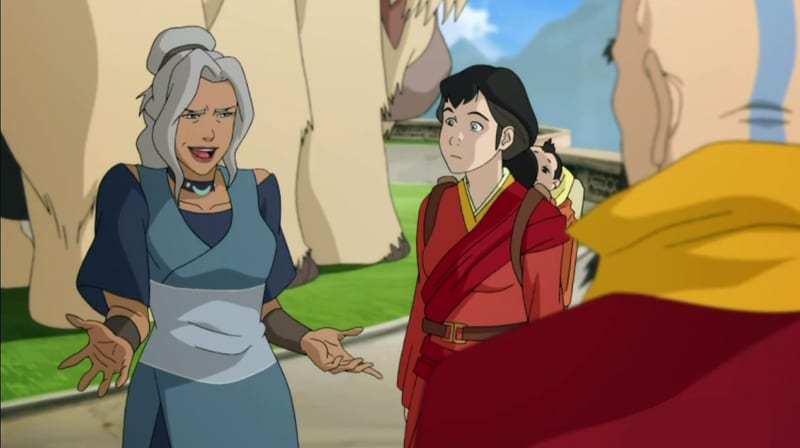
It’s easy for us to dismiss these Watsonian issues, because it’s just a matter of “oh, this comic doesn’t quite work with the shows’ canon.” We’ve taken that attitude before with some of the ATLA comics (out of necessity), and while it’s disappointing, it’s not like reading it hurts anything. However, there are Doylist concerns we personally have as well.
The biggest one we see is that by injecting homophobia as a tension in what we consider to be a hamfisted manner, it perpetuates the message that Homophobic is the Default Society. It’s apparently so difficult to imagine a setting with no systemic homophobia, that even when there’s one that completely 100% lends itself to it—and may as well define itself by it—it’s not depicted. The issue here is that it sort of rests on the assumption that man is just inherently evil, or queer individuals are inherently doomed to suffer. Even female demigods who are looked to as the spiritual leader (again, like the Pope, if the Pope is continually reincarnated and physically stronger than everyone)…they will still get shit on if they dare kiss another woman.
No thanks.
The other implication, and this is a milder one (and definitely one that’s more personal to us), is that it further drives the idea that there is no conceivable storyline for two women dating that isn’t about their struggling for their right to exist. It’s no secret that wlw characters have been piled on over and over, to the point where in 2016, we had to call the string of their corpses on our TV screens the “spring slaughter.” Obviously, DiMartino’s story is miles better than this and not even comparable.
But at the same time, we’re sorry—there’s more imaginative tales to tell. There’s more aspects to navigating a wlw relationship than being hated and getting pooped on. Sure, it happens, but why the fuck do we always need to be reminded of this? And even though we praised this story for existing given that it’s aimed at a younger audience than typical comics allowed to address such things, is it actually progressive to show kids that they are different and this is always going to be a tension? That even a badass like Kyoshi failed to change anything and find acceptance?

It’s great that we see Korra and Asami’s friends and family reacting with nothing but smiles, but there’s no reason why that shouldn’t have been the default reaction, for their reality or ours. Hell, Bolin’s response would have played exactly the same, even absent of Tonraq’s warning, or Kya’s expo-dump.
You know, when Korrasami was called “transgressive” by Vanity Fair back in 2014, it wasn’t because we were told on the show that Korra and Asami were both women. It’s not because there were any obstacles for them getting together, or any internal angst when they realized that this was something they wanted to pursue. It was transgressive because it simply was.
We didn’t need the concept of homophobia beamed in from Burbank in 2017 for us to see that Korra and Asami make a strong couple and can be supportive of one another, or that others would have responded positively to their relationship. Wynonna Earp manages to walk this line beautifully, and that’s for a show set in a contemporary setting, so we know it’s possible. Not to mention, this exact story could have been told so easily in allegory, like we suggested in our review.
Again, we’ll admit to heavy subjectivity here. Perhaps since the target audience is so young, it’s unfair of us to hammer on this point. After all, do kids even have pieces of media that deals with homophobic feedback so explicitly? But we don’t think it’s unreasonable for us to be tired of it, or to question the value of it against the host of other options Mike had when approaching this. Especially given that Turf Wars suggests a worse world than our own with regards to homophobic feedback. You know…for kids!

It’s not like kids should be raised blind to what’s out there, nor is that what we’re advocating. But we really fail to see what institutionalized homophobia adds that’s of particular benefit. Fine, leave Tonraq’s warning and the bit about the Water Tribes (even if we’d have nits to pick there)… Would anything really be lost in message or impact had the page about Sozin and Kyoshi been removed?
“These pretzels are making me thirsty!”
May we be a good deal subjective for a tiny bit longer?
The Kya conversation didn’t land for us, not just because it broke from the canon of the franchise, or because it began with a 60-year-old woman Korra and Asami are not particularly close to offering an uninvited remark about how beautiful of a couple they are (are we alone in thinking that this would be weird??), but because the entire premise of the conversation is a little cringe-worthy in our opinion.
First of all, Kya lives in the Southern Water Tribe with her mother. Yeah, she’s not glued there, and we know she’s helping with relief efforts at the evacuee camp, but our point is that a conscious decision was made to warp her to the United Republic, simply because “who else could offer gay advice but another gay?” (Yes, we know Korra and Asami are bisexual. We’re using ‘gay’ as an umbrella term to comedic effect. Did it work?)
Only Kya could have been used here, obviously. We’re sure Tenzin wouldn’t have wanted to help Korra and Asami navigate what could be a tense situation, especially with his protectionism towards Korra and his extensive knowledge of history that his father pushed into his brain. Though in fairness, he’d totally be the first one to gal-pal them.
Perhaps if everything else had landed, we would have been happy to view this conversation as a nice moment with a kind of mentor who had a shared intersection that allowed for better mutual understanding. But because of these other issues we had, we’re now finding ourselves a little more pissed off at the tacit implication that straight people wouldn’t be able to empathize or offer guidance. Use Pema instead! She loves giving unsolicited (and heavily questionable) relationship advice!
As a quick aside to that point, we also really could have done with someone other than Kya understanding that two women in their twenties going on a vacation alone together might be an indication of something a bit more than friendship. Gal-pal syndrome makes a little bit of sense here, but not to the point where only gay characters can tell because of magical gaydar. We bisexuals, contrary to popular belief, are not particularly special.

Honestly? We didn’t talk a ton about what “benevolent homophobia” would look like, but this sort of fits the bill. The idea that queer individuals are so different and their love is so unique, only another queer individual could possibly understand. Maybe that’s not how anyone else read this moment, but it was just a tone that was hard for us to shake.
Secondly, why is Kya saying these things? We don’t mean her motivation, because it’s clear that she wants to help them out with such potential difficulty ahead. What we mean is: she’s telling them rather obvious political and historical information about what is apparently a major prejudice, which they should already know by the very nature of being citizens of this world. They’re not bisexual tourists from Burbank in 2017 (or are they?), and would surely have learned how Kyoshi was received or the type of oppression that Sozin inflicted on his own people. Korra had personal lessons from the White Lotus, one of longest-standing orders and therefore witnesses to history, and we have to assume the rather affluent Hiroshi Sato got his daughter education that included these basic lessons.
We know these are nitpicks, because sure, Kya probably would have paid more attention to how this issue manifested since it affects her person (and clearly no one else would give a shit, because it’s not like her brothers care about her well-being or anything). But there’s something that rubs us the wrong way about the way Mike went about scripting this: the magical gay unicorn with her magical gaydar being the only person who knew they were together, popping up in a city she doesn’t live in, just to vomit information that they should already know. It feels incredibly infantilizing and pandering to us, even though we can recognize it was meant as nothing more than a nice moment of advice from someone who understands, and was probably very uplifting to readers who would have (or already have) strongly benefited from a Kya of their own.
Why can’t we just like it? What is wrong with us?

“It’s happened. I’ve become George. I’m George!”
We’re not sure we can impart just how much we realize what we sound like. Petty, whiny, and a good deal too intense. It’s to the point where we were doing Plinkett impersonations as we were trying to lay out this argument, calling out our own ridiculousness because of how deeply felt our dissatisfaction was with a comic that’s…mostly nice.
At the end of the day, we don’t see our issues being mere nitpicks. Comics based on a TV-show have one job to do: work with the TV-show. Expand on it; don’t throw its foundation into the toilet. But in our eyes, this just pushed the flusher.
We do think overall the existence Turf Wars is a positive in the world. It’s a comic for kids that shows two women in a relationship loving and supporting one another, while their friends and family do the same. What can we possibly object to? (Except for everything we just did.)
Sure, it greatly upset and angered us, but we know that there are those who felt compelled and validated by it too. Especially since while the portrayal of homophobia didn’t land for us, we’re pretty lucky in this department. We both come from accepting families (at least, with time) and had almost no internal difficultly grappling with our understanding of our own sexualities. What Korra and Asami are up against in this scenario and how homophobia was described? That’s lived experience for many readers.
What’s fun about engaging in fandom and media analysis is that we all have our unique backgrounds and identities that inform our opinions, reception, and takeaways. Media provides us with a really cool platform that can put those different experiences into a common language and enable us to reach mutual understandings or see things in completely different way. We both love this aspect, which is why we’ve been writing about nerdy shit for as long as we have, and we’re excited to do it with Turf Wars. It’s just that we can’t consider it as being grounded in canon. So we won’t!
But that’s okay, because we personally don’t need to. We can still have a ton of fun analyzing it (and plan to…Varrick’s behind it all!), and frankly taking the setting for what it is, we like a lot of it. Something that got lost in translation in our review was that we found the way Korra and Asami interacted with each other to be damn near perfect, and we could write odes to their tent-scene debating the meaning of “practical”. We were just…such sticklers about what we view as clashes with the show that we kind of forgot about the characters. It’s always the characters. So yeah, giant idiots, like we said.
By the way, there’s no issue if you do think it fits with canon and works well. Analysis is the most fun with different viewpoints and debates, and we’d love to hear your thoughts. There’s no objective truth here because…this is interpretation of fiction. Speculative fiction at that. So let’s just enjoy what we have.
For us? Well, sometimes you can’t be afraid to mix it up.

Images courtesy of Dark Horse Comics, Viacom, and NBC


